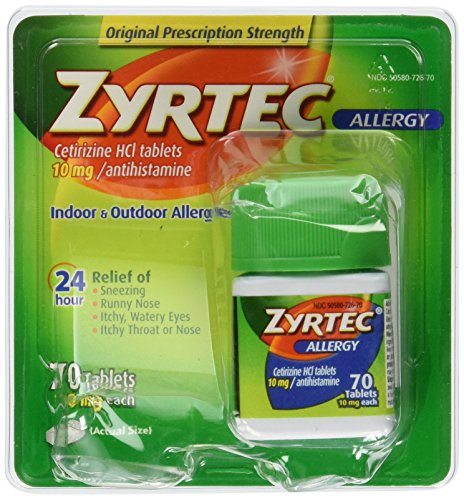
Allergies in dogs suck and for so many reasons. It disturbs your dog and so it disturbs you and everyone just ends up feeling miserable. One common treatment used for allergies in dogs, although a human drug, is Zyrtec. So, it begs the question, how much Zyrtec for a dog?
Because Zyrtec is a human drug, you need to especially careful about dosage. Besides that, Zyrtec is also known to have a couple of side effects. Well, just like every other drug. So, naturally, this further increases the need to be careful with the drug.
But before we go into Zyrtec and dogs, we will be looking at allergies in dogs, first of all. Understanding allergy symptoms in dogs as well as how they come about can help manage or even prevent your dog from coming down with allergies because here’s an important truth to note.
Zyrtec and other allergy drugs do not take care of the root problem, they only relieve symptoms. Hence, the best way to attend to pet allergies is to identify the allergen(s) and get rid of it or them.
Table of Contents
Allergies In Dogs

So, how do allergies happen in dogs?
Well, pretty much like they happen with humans and nearly every other organism. Fido comes in contact with an allergen either in his food, water, or environment. When this happens mast cells in your dog’s skin release histamine in large quantities which then triggers an inflammation as a result of the release of histamine and other inflammatory chemicals.
When inflammation occurs, symptoms such as hotness in the affected area, itchiness, redness, and swelling are triggered. And for each time your pup comes in contact with an allergen, this inflammatory reaction and its accompanying symptoms will follow. So, if your dog is encountering the offending allergen in his food or in the yard, the itching and scratching will never end. (Click here to read our article: Hypoallergenic Dog Food: Feeding Dogs with Allergies).
Remember that the best way to treat allergies in dogs is to discover what the offending allergen is and take it out of your dog’s food or his environment. Now, that’s easier said than done which is why, oftentimes, people will resort to anti-inflammatories to reduce the severity of reactions from allergies.
Now, keep in mind that anti-inflammatories do not prevent inflammatory reactions, they only help to treat the reactions after they have occurred. So, even if you’re going to be using Zyrtec, it’s still important to work with your vet to identify and take out the offending allergen.
Signs Of Allergies In Dogs
When we think of allergies, we typically think of watery eyes, runny noses, and itching. However, there are other symptoms of allergies in dogs. If your dog seems allergic, you might notice any one of the following symptoms:
- Redness of the skin.
- Irritation of the skin.
- Swelling.
- Intense itching.
- Repeated rubbing of the muzzle and the face.
- Biting of the legs and paws.
If these symptoms are left unattended, it could lead to loss of hair as well as skin infections, yeast infections, bacterial infections, and hot spots. It could also lead to hives if cases are extreme which could eventually lead to anaphylactic shock.
Symptoms of anaphylactic shock include sudden diarrhea, vomiting, excessive drooling, seizures, coma, and sometimes, even death.
You might also find that dogs with anaphylactic shock have gums paler than normal rather than a healthy pink, as well as cold limbs and paws. If you suspect your dog is displaying any of these symptoms, then you must contact your vet immediately.
In addition to the signs you’ve already confirmed, your vet will check for abnormalities in heart rate and pulse after which he will confirm if, in fact, your dog has anaphylactic shock and treat your dog.
What Is Zyrtec?
[amalinkspro type=”showcase” asin=”B004AI7G3W” apilink=”https://www.amazon.com/dp/B004AI7G3W?tag=dpg-amalinks03-20&linkCode=osi&th=1&psc=1″ new-window=”true” addtocart=”true” nofollow=”true” sc-id=”4″ imgs=”LargeImage” link-imgs=”false” specs=”Relief from sneezing, runny nose, itchy and watery eyes~~~Also relief from itchy throat or nose~~~24-hour relief~~~” btn-color=”#ff9900″ btn-text=”View on Amazon” alignment=”aligncenter” hide-prime=”0″ hide-image=”0″ hide-reviews=”0″ hide-price=”1″ hide-button=”0″ width=”750″]Zyrtec Allergy Relief (10 mg), 70 Tablets[/amalinkspro]
If you come down with allergies seasonally, you’ve definitely heard of Zyrtec — an over-the-counter anti-histamine use to treat symptoms of allergies. It’s usually prescribed to humans who suffer allergies during seasonal changes with symptoms like red, itchy eyes, and stuffy noses.
Zyrtec (or more correctly, its active ingredient, Cetirizine) works by blocking histamine so that it does not trigger the intense inflammatory reaction it is known to trigger in dogs.
Unlike most other anti-histamine drugs like Bendaryl, Zyrtec does not cause drowsiness in the individual that takes it in. This is because Zyrtec belongs to a different class of anti-histamines and as such does not cause drowsiness as we know it.
Zyrtec can be used in the treatment of long-term allergic reactions typically caused by food and seasonal allergies.
But besides seasonal allergies, you can also use Zyrtec to treat short-term reactions such as stings, insect bites, poison oak, and poison ivy.
It’s important to note that the FDA hasn’t exactly approved the use of Zyrtec in animals. However, more and more vets are recommending it in the treatment of allergies in dogs. They recommend it especially for allergies related to contact and atopic dermatitis. Symptoms of both range from itching to swelling to inflammation to hives.
How Much Zyrtec For Dogs? — Zyrtec Dosage For Dogs
Generally, and like most drugs, Zyrtec is administered to dogs based on size. But typically, it will be taken once daily and orally too. However, this is just the common way it is administered, not exactly a hard and fast rule. So, you must see your vet before deciding on any dosage of Zyrtec for your dog.
Again, the dosage of Zyrtec will vary based on what it is being administered for. For instance, contact or atopic dermatitis will require a different dosage from an allergic reaction from a bee sting.
That said, usually, for atopic dermatitis, 0.5 milligrams of Zyrtec is administered per pound of dog weight every 24 hours.
And for allergic dermatitis, 0.5 milligrams of Zyrtec is administered per pound of dog weight every 12 hours.
Also, some vets might recommend a dosage of 5 to 10 milligrams of Zyrtec for your dog for the entire day, depending.
This is why the smart thing to do when it comes to administering Zyrtec for your dog is to consult your vet first.
How Much Zyrtec For Dog? — Liquid Dosage
Unfortunately, liquid Zyrtec is no longer being made. So, if your dog prefers liquid medicine, you might have to resort to Children’s Aller-Tec. This is a liquid medicine containing about 1 milligram per liter of Cetrizine. It can also help to treat allergies in dogs. Dosage is usually 0.5 milliliter per pound of body weight.
How Much Zyrtec For Dog? — Overdosing
There are very slim chances that your dog will overdose when taking Zyrtec. In an experiment carried out test animals, these animals were administered a dosage about 220 times higher than what is generally considered safe for human use. Interestingly, these animals appeared to handle the drug just fine.
Nonetheless, if you’re afraid that your dog has overdosed on Zyrtec, then contact your vet immediately.
Side Effects Of Zyrtec In Dogs
Zyrtec usually does not produce many side effects in dogs which is great news for pet owners. However, there are still a few concerns related to the use of Zyrtec in dogs.
From research, antihistamines only have a 30% success rate in dogs. That is, only about 30% of dogs actually experience some relief when taking Zyrtec for their allergies. In fact, sometimes, that percentage is less. And, of the 30%, 25% of these dogs come down with one adverse reaction or another.
As we have said before, antihistamines do not solve the problem of allergies in dogs. They are simply like putting a band-aid on the actual problem. They simply treat the symptoms, they don’t treat the underlying cause of the problem.
Unfortunately, sometimes, that problem is not as a result of a change in season. And until the root cause of the allergy is taken care of, your dog will continue to produce the symptoms associated with allergic reactions.
That said, common side effects of Zyrtec in dogs is excessive salivation and vomiting. You can prevent (or reduce) the occurrence of these by administering the pill alongside a small portion of food.
Now, for smaller dogs taking high doses of the drug, drowsiness might also be observed. For this reason, it’s better to administer Zyrtec to your dog starting with the lowest dose possible first. After that, you can begin to work your way up to higher doses, if you need to. This could help reduce the chances of drowsiness in your dog.
Other symptoms of Zyrtec in dogs might include constipation, impulsive responses, and urine retention. In extreme cases, graver symptoms such as kidney and liver problems might also be exhibited.
If your dog is currently on certain depressants for the central nervous system such as alprazolam or diazepam, it’s not the best idea to administer Zyrtec to your dog as the combination of both drugs could bring about a heavy sedation in the dog.
Is Zyrtec Safe For Dogs?
From what we observe, Zyrtec is, generally, well tolerated by dogs. So, dogs with itchy skin may benefit from the use of Zyrtec. However, it is important that this drug not be used for senior dogs as their kidney and liver will have a tough time clearing the drug from the system completely and efficiently. For such dogs, other treatment options should be explored.
The science community seems to be divided on whether or not Zyrtec can be used in pregnant dogs. Some say it is safe and hasn’t been shown to cause any untoward effect in fetuses. Others say there isn’t enough evidence to determine if Zyrtec is safe for developing fetuses or not.
One thing they agree with, though. Zyrtec does seep into a nursing bitch’s breast milk, and nursing puppies are way too young to begin taking conventional drugs like Zyrtec. Therefore, it is not advisable to administer Zyrtec to a nursing bitch.
For dogs with kidney problems, it’s important you do not administer Zyrtec to such dogs due to the inefficiency of their kidneys along with the fact that Zyrtec causes urine retention. This urine retention can worsen pre-existing conditions which you wouldn’t want.
Dogs with liver issues as well, should not be given Zyrtec as it could worsen issues.
In all, and like we always say here, make sure your vet is informed before you make any decision on any medication to give your pet. If your vet knows everything your dog is on, they will be in a better position to recommend drugs that are less likely to cause adverse effects in your dog.
What Is Zyrtec-D? — Is It Safe For Dogs?
Zyrtec-D is a similar product to Zyrtec also produced by Zyrtec. However, rather than Cetirizine, the active ingredient in this drug is pseudoephedrine. Pseudoephedrine is a popular decongestant commonly used in human cold medications.
Please note that Zyrtec-D is NOT safe for dogs. While dogs can tolerate cetirizine, pseudoephedrine is extremely toxic to dogs. So, always ensure when you’re making your purchase that you’re getting Zyrtec and not Zyrtec-D.
If you mistakenly administered Zyrtec-D to your dog, then consult your vet immediately whether or not your pet is showing any signs of distress.
Typically, when consumed Zyrtec-D causes high blood pressure, seizures, and can even cause death as well in dogs. So, please be on the lookout.
Alternative Home Remedies To Zyrtec For Dogs
If Zyrtec is not an option for your dog, and you’re looking for home remedies with which to help your dog feel better, we have a few considerations. These methods are safe, effective, and have virtually no side effects.
1. Oatmeal Bath
Oatmeal is a great remedy for itchy and irritated skin. Simply add some water to oatmeal and then apply it on the affected part of the skin. Or you can also fill up your tub with water and then pour the oatmeal into it. Let your pup soak in it for just about 10 minutes. After this is done, he will much relieved and come out with a less irritated skin.
2. Coconut Oil
[amalinkspro type=”cta-btn-css” ctabtn-id=”” asin=”B00DS842HS” apilink=”https://www.amazon.com/dp/B00DS842HS?tag=dpg-amalinks03-20&linkCode=osi&th=1&psc=1″ addtocart=”true” new-window=”true” nofollow=”true” alignment=”alignright”]Buy on Amazon[/amalinkspro]
Another fantastic home remedy is coconut oil. Coconut oil does not only relieve itching and irritation, it also prevents the growth of parasites as well.
Make sure you get coconut oil that is high in lauric acid. This way, it will be more effective. To use this method, you’d have to apply a little amount of the coconut oil directly on your dog’s coat. Or you can even feed it to your dog as well.
Now, if you’re choosing to feed your dog the coconut oil, feed only a small amount. Begin with about a quarter of a teaspoon for dogs andn1 teaspoon to 1 tablespoon for large dogs. Give it to them once to twice daily, and always with meals.
Remember, excess intake of oil will cause diarrhea. So, you must give your dog only little at a time and not more than twice in a day.
3. CBD Oil
[amalinkspro type=”cta-btn-css” ctabtn-id=”” asin=”B07RDJ3L6M” apilink=”https://www.amazon.com/dp/B07RDJ3L6M?tag=dpg-amalinks03-20&linkCode=osi&th=1&psc=1″ addtocart=”true” new-window=”true” nofollow=”true” alignment=”alignright”]Buy on Amazon[/amalinkspro]
Full-spectrum CBD oil is yet another home remedy you can try. From what research tells us, CBD oil is great at improving skin health especially in animals that have sensitive skin.
Go for CDB oil that is completely natural, free from GMOs, soy, and is lab tested.
When you get your CBD oil, you can either squirt a bit of the oil into your dog’s mouth directly, or you can mix it into his food, or you can add to your baking recipe when baking his favorite treats (if you bake).
4. Premium Wild Alaskan Salmon Oil
[amalinkspro type=”cta-btn-css” ctabtn-id=”” asin=”B0764LW538″ apilink=”https://www.amazon.com/dp/B0764LW538?tag=dpg-amalinks03-20&linkCode=osi&th=1&psc=1″ addtocart=”true” new-window=”true” nofollow=”true” alignment=”alignright”]Buy on Amazon[/amalinkspro]
Premium Wild Alaskan Salmon Oil is really good as it helps to relieve itchy and dry skin. It also moisturizes your pet’s skin and coat from the inside out. This way, your pet’s coat appears, soft, shiny, and healthy.
It’s great dor dogs with seasonal allergies with symptoms like runny nose and itchy skin. Plus, it also works as a great natural anti-inflammatory.
5. Honest Paws Restore CBD Dog Treats
Sometimes, itching in dogs is as a result of a digestive health issue. Some dogs are allergic to certain foods and these could lead to certain symptoms such as dry and itchy skin. Fleas and ticks could also cause dry and itchy skin as well.
If any of the above is the case with your dog, then you might want to try the Honest Paws Restore CBD Dog Treats. They are tasty, coconut flavored dog treats which melt in the mouth.
What makes them really effective, though, is the presence of terpene. Terpene is a class of organic compounds which are produced by plants. When taken in, they help to support healthy skin and coat in dogs.
This video lists other natural remedies you can use for your dog with itchy skin from allergies.
Conclusion
In conclusion, in treating dogs with allergies with Zyrtec, here is a roundup of all the things to do to administer it safely.
First, you must speak with your vet first before administering Zyrtec to your dog.
Secondly, it is not advisable to administer Zyrtec to a dog who suffers kidney or liver disease. Dogs on medications that depress the central nervous system such as alprazolam, Ativan, and diazepam, should not be given Zyrtec as well, as it can cause heavy sedation.
Also avoid giving this drug to nursing bitches as some quantity can seep into their breast milk which is not appropriate for puppies that age.
Finally, never give your dog Zyrtec-D as it contains pseudoephedrine that is highly toxic to dogs and can even kill them. If your dog mistakenly ingested it, consult your vet immediately.
For more information on how to care for dogs with allergies, click here to read our article: Fall Season’s Allergies in Dogs: Symptoms and Treatments.




